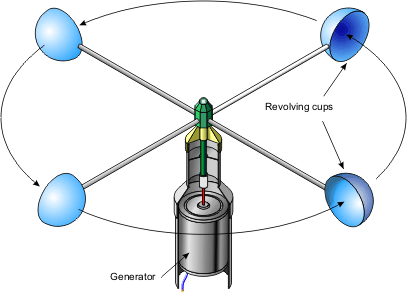A mercury barometer consists of a glass tube with a small reservoir at the bottom. A small amount of mercury fills the reservoir. As soon as the barometric pressure changes, the mercury in the tube goes either higher (with an increase of the pressure) or lower (as the pressure falls). The marks on the side of the glass allow for measuring a change in the pressure in millimeters (Lutgens and Tarbuck 411).
The higher the pressure gradient is, the greater the gap in temperature of the air on lower and higher altitudes is and, therefore, the greater the speed of wind is (Lutgens and Tarbuck 425). Therefore, the pressure gradient is in direct proportion to the speed of the wind.
Due to the Coriolis effect, wind flows to the right of its direction if it heads north, and to the left if it blows west (Lutgens and Tarbuck 428).
Though a cyclone and an anticyclone may seem very similar, there is an obvious difference between the two: the wind in the cyclone travels in a direction that is different from that one of the anticyclone (Cenedese and Linden 2). In a cyclone, the air currents are directed upwards and inwards. In an anticyclone, the air currents travel outwards and downwards. Both systems rotate clockwise in the Northern hemisphere and counterclockwise in the Southern one (Lutgens and Tarbuck 437).
A sea breeze is a type of breeze (light wind), which can be observed along the coast of a sea. Though the wind speed might seem insignificant, it leads to the creation of a sea-breeze front, which, in its turn, leads to a drop in the average temperature of the area (Lutgens and Tarbuck 438).
An anemometer is a device that measures wind speed. It should be kept in mind that there is a second type of anemometers, i.e., the one that measures the pressure of the wind. However, as there is an obvious connection between speed and pressure, the two types are rarely specified. A number of anemometer constructions exist (v 439); the most common one presupposes that four hemispherical cups should be installed on a metal shaft connected to a generator (Picture 1).

A southwest wind blows from northeast to the southwest. The confusion that may emerge in the process of deciphering the names of air currents is quite understandable. To avoid it, it is necessary to keep in mind that winds are named after the direction that they blow to; therefore, where they blow from is the exact opposite (e.g., a westward wind blows from east to west) (Lutgens and Tarbuck 437).
If it was not for sweating, people would be suffering from a sharp rise in temperature, with a number of lethal outcomes. In the process of evaporation, water molecules release the energy that is accumulated in the body; as a result, the body experiences a drop in the amount of energy and, therefore, a decrease in the body temperature (Lutgens and Tarbuck 440).
A jet stream is usually defined as an air current of a rather high speed, which can be found in the atmosphere of the Earth (Lutgens and Tarbuck 442). As a rule, jet streams are very narrow, though some exceptions exist (Lutgens and Tarbuck 443). Most jet streams on the Earth are represented by westerly (westward) winds with a rather curvy flight trajectory.
Works Cited
Cenedese, Charles and Peter F. Linden. “Cyclone and Anticyclone Formation in a Rotating Stratified Fluid over a Sloping Bottom.” Journal of Fluid Mechanics 381 (1999), 199–223.
Lutgens, Frederick K. and Edward J.Tarbuck. “.Moisture, Clouds and Precipitation.” Foundations of Earth Science. 7th ed. Upper Saddle River, NJ: Prentice Hall. 2014. 409–444. Print.